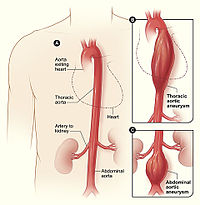
Photo from wikipedia
Background Implant-based reconstruction represents the most common form of breast reconstruction after mastectomy. Although the complication rate has lowered owing to the current advances, various implant-related complications are still a… Click to show full abstract
Background Implant-based reconstruction represents the most common form of breast reconstruction after mastectomy. Although the complication rate has lowered owing to the current advances, various implant-related complications are still a problem. There have been few reports discussing chest wall deformation following implant insertion. The aim of this study was to quantify chest wall depression (CWD) after breast implant insertion and identify possible risk factors. Methods Patients who underwent unilateral direct-to-implant reconstruction were included in the study. We measured the pre- and postoperative antero-posterior length of the chest wall and used a CWD ratio to measure the change in length. Multivariate analysis was performed with factors with P values of <0.2 in univariate analyses to identify factors associated with CWD. Results A total of 57 patients were included in this study. The pre- and postoperative difference of antero-posterior length was statistically significant using a paired t-test. Average depth of CWD was 4.16 mm (range, −2.16 to 13.82 mm). In multivariate analysis, capsular contracture and age were the independent prognostic factors correlated with CWD. Conclusions This study showed the possibility of CWD following implant insertion. Surgeons and specialists should be aware of the possibility and risk factors of CWD following implant insertion to better inform patients.
Journal Title: Gland Surgery
Year Published: 2022
Link to full text (if available)
Share on Social Media: Sign Up to like & get
recommendations!